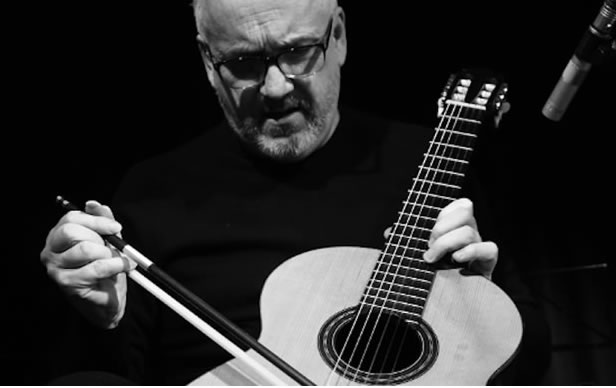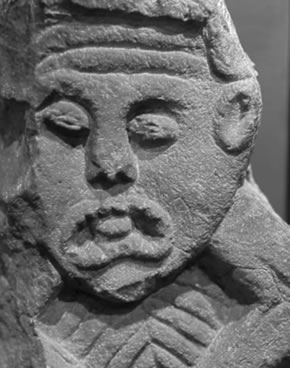Ancient Carvings Known As Sheela-Na-Gigs Inspire Irish Composer
Benjamin Dwyer's unique classical composition to be performed at Irish Cultural Centre

|
An encounter with an ancient Irish stone carving, known as a 'Sheela-na-Gig', captivated composer and musicologist Benjamin Dwyer (above) so much that it led to a ten-year odyssey to find out more about the carvings and a mission to incorporate them into his music.
The result is a unique classical composition, 'Sacrum Profanum' which will be performed at the Irish Cultural Centre in Hammersmith on Saturday September 10th at 8pm.
Sheela-na-gigs are the enigmatic, ancient feminine stone carvings found in Ireland and parts of Britain, often with skeletal bodies and enlarged genitalia. The name is thought to derive from the Irish word for 'fairy, which is ' sidhe' (pronounced SHEE). There are an estimated 120 of the carvings in Ireland and forty in Britain, though they have been discovered across Europe and even in Scandinavia. They are often found on stone walls or over church doors or in the walls outside castles.
Benjamin, who is Professor of Music at Middlesex University, has spent the last ten years travelling across Ireland studying, photographing and sketching these mysterious figures.
Responding artistically through the Sheela ‘as witness’, Dwyer has created a unique work exploring themes such as feminism, colonialism, identity, religion, rite, landscape, sexuality and the disintegration of Gaelic culture.

The 'Sheelas' have been witnesses to so much of Irish history, colonialism, to the Famine, and State and religious oppression of women, he says, and he describes his work as translating into sound the 'aesthetics of damage', of the ages.
"We're not dealing with goddesses, with a perfect reflection of the female form here, I'm actually challenging the established narrative here with the work. For example in the piece called 'Hag' I'm looking at her anger, it is like a stare back to disable the male gaze looking for female perfection.
"The Sheelas are a composite of women, the sex, birth, death, good and bad times, decay and devastation. They are icons for understanding the trials that women had to bear."
Sheela-na-gigs are often balding with wrinkled foreheads and chevron-shaped striations on their faces. They often have excessively large heads, eyes and ears. They have often been stolen from their sites and found in museums or in private collections.
Numerous theories have been put forward as to what they might represent.
One theory is that they are icons of fertility that facilitate conception and childbirth. Another is that they are warnings against lust or the transgression of religious taboos.
Opposing these propositions is the notion that they are pagan Goddesses of female empowerment and untamed sexuality. They are also seen as symbols of the power of nature to give and take life, as defensive talismans against the evil eye, or as emblems and facilitators of sovereignty over land or communities.
Benjamin was first introduced to the sculptures when he saw one on display at Rothe House, Kilkenny, and began to imagine how they could be a source of thematic material.
After the Sheelas 'cast a spell on him' Benjamin began to write pieces that radically altered his thinking in terms of music and its function and place in contemporary settings.
The composition investigates these themes through raw, visceral, often abject but ultimately poignant and deeply affecting music.
He says; "Some people might question how this strange and distorted physiognomy could translate to music, but I often uses myth, literature, symbol, feminism and post-colonial theory as inspiration."
His work, 'Umbilical' (2011) is a retelling of Oedipus from the perspective of Jocasta (Oedipus' mother), while 'Scenes from Crow' (2000) is inspired by the work of a similar name by Ted Hughes. His work in 2000, 'Rajas, Satva, Tamas', is inspired by Vedic philosophy.
With a score that combines contemporary music, interfacing with traditional Irish forms, instruments and sean-nós singing, 'Sacrum Profanum' offers perceptive critiques of contemporary exploitations of Irish culture.
For example, the Sola Viola', a sad and haunting piece, reflects the tragic elements of their history when in the 17th century, clergy in Tuam were told to hide and destroy the Sheelas.
The opening movement , the Chloran', with its jerky and discordant flute music speaks to the 'crudity' of the carvings.
This is the first time that a composer of classical contemporary music has written such a work about the Sheelas, although they have been the subject of poetry, including by Seamus Heaney.
He admits that this work may be challenging to an audience and praises the Irish Cultural Centre for having the vision to stage such an experimental work.
He also laments that schools in Ireland and the UK do not focus enough on classical music.
Irish classical music composition is a minority area, despite having some major talents. In terms of music, most attention and funding is either on traditional Irish music, or attention is on the commercial works such as Riverdance, he says. But there is a wide spectrum of music that can be classified as 'Irish' and classical composition is very marginalised.
"If you asked people to name four Irish writers I don't think they would have any difficulty. If you asked them to name four Irish classical composers, they would struggle. We are not nationally valued. I do worry for young composers, I am lucky that my work with Middlesex University allows me to do long-form pieces as well as research."
Benjamin grew up in Dublin but was not exposed to classical music growing up. As a teenager, he loved the work of Jimi Hendrix, and Bob Dylan and played in a band.
After hearing a classical guitar concert, he was "blown away" and eventually sold his record albums to buy a guitar and take classical guitar lessons.
He became interested in the works of Stravinsky and Mahler, and practised his guitar for several hours a day, eventually taking a degree in music, a Masters Degree at the Royal Academy in London and a Phd at Queen's University Belfast.
He became a world-renowned classical guitarist, playing with orchestras and in prestigious venues. However, he began to feel limited in his musical expression and wanted to expand his musical horizons.
He left Dublin and spent ten years living in London, working as a Professor of Music at Middlesex University, composing, and researching. He has recently relocated back to Dublin, but he will continue his university work with Phd students and in the area of music research.He also c0-founded a classical music festival, Music 21, which ran for 20 years in Dublin.
'Sacrum Profanum' had its premiere in Cardiff last year and Benjamin says he is looking forward to performing in London.
The concert will also feature Benjamin playing bowed guitar as well as musicians Garth Knox (viola), Emma Coulthard (flutes) and Siobhán Armstrong (medieval Irish harp, voice – and Sean Nós). Poet Jona Xhepa has written a specially commissioned poem entitled 'Sheela-na-gig'.
The work also incorporates a number of Irish texts sourced by Siobhán Armstrong.
"I don't write for an audience and I know that composers like myself are in a small bubble. But you can write avant garde music and still be Irish you know."
Read more about Benjamin Dwyer’s work on Sheela-na-gigs.
The concert starts 8pm: Tickets are £15 / £13 concessions.
Irish Cultural Centre, 5 Black's Road, London W5 5DTThis Show will be followed by a Q&A with Benjamin Dwyer.
The Irish Cultural Centre has a remit to deliver the best Irish arts and education programme outside Ireland. The Centre also plays an active role in the wider community with open-access programme for all ages, interests and backgrounds.
Anne Flaherty
Like Reading Articles Like This? Help Us Produce More This site remains committed to providing local community news and public interest journalism. Articles such as the one above are integral to what we do. We aim to feature as much as possible on local societies, charities based in the area, fundraising efforts by residents, community-based initiatives and even helping people find missing pets. We’ve always done that and won’t be changing, in fact we’d like to do more. However, the readership that these stories generates is often below that needed to cover the cost of producing them. Our financial resources are limited and the local media environment is intensely competitive so there is a constraint on what we can do. We are therefore asking our readers to consider offering financial support to these efforts. Any money given will help support community and public interest news and the expansion of our coverage in this area. A suggested monthly payment is £8 but we would be grateful for any amount for instance if you think this site offers the equivalent value of a subscription to a daily printed newspaper you may wish to consider £20 per month. If neither of these amounts is suitable for you then contact info@neighbournet.com and we can set up an alternative. All payments are made through a secure web site. One-off donations are also appreciated. Choose The Amount You Wish To Contribute. If you do support us in this way we’d be interested to hear what kind of articles you would like to see more of on the site – send your suggestions to the editor. For businesses we offer the chance to be a corporate sponsor of community content on the site. For £30 plus VAT per month you will be the designated sponsor of at least one article a month with your logo appearing if supplied. If there is a specific community group or initiative you’d like to support we can make sure your sponsorship is featured on related content for a one off payment of £50 plus VAT. All payments are made through a secure web site. |
September 3, 2022